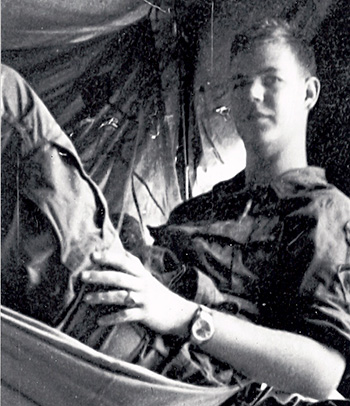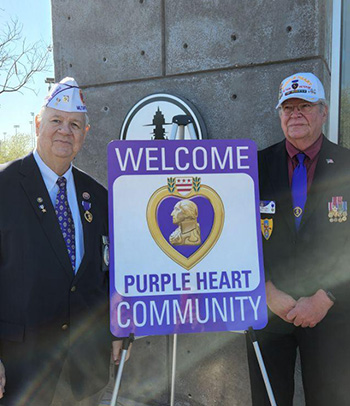Sacrifice is a word Veterans and those within the military community know well. From the onset of training, men and women in the Armed Forces dedicate themselves to fighting for their country, often traveling miles and miles away from family and home.
Every year on Aug. 7, we celebrate Purple Heart Day to recognize the men and women who have made the ultimate sacrifice — those who have been wounded or killed in service to our country. It’s a day to hear their stories, honor their service and reflect on their contributions to our history.
“It’s important to understand the history and the legacy of the Purple Heart and how so many Americans were wounded in combat or made the ultimate sacrifice with their lives defending their country.” – Charles Byers, Purple Heart recipient
The Purple Heart is our nation’s oldest military honor and one that evokes the courage and selflessness all Service members demonstrate when they pledge to defend and protect our freedom.
Today, as we learn more about the Purple Heart, its history and the incredible sacrifice of Purple Heart honorees, we highlight Charles (Chuck) Byers, a Purple Heart recipient who served in Vietnam and continues to work tirelessly on behalf of his fellow Veterans.
History of the Purple Heart
The Purple Heart dates back to George Washington. In 1782, he awarded the original Purple Heart, known as the Badge of Merit, to soldiers for “any singularly meritorious action.” The badge faded from use but was revived in 1932, this time by Army General Douglas MacArthur as the Purple Heart we know today—a bronze bordered, purple, heart-shaped medal bearing Washington’s profile and coat of arms. In 1944, during World War II, it was given the purpose we know it for today—to honor those who have been wounded or died in combat. Over the years, the criteria have changed slightly concerning who’s eligible to receive a Purple Heart, but consistently it remains a way to reflect on the bravery of those who have fought for our country and sacrificed so much.
One Man’s Journey in Vietnam

Charles served as a Senior Combat Medic in Vietnam in 1967-68. To many of his fellow soldiers, he was “Doc” or “Big Band-aid.”
“I would go out on patrols during the day and helped out with ambush patrols at night,” says Charles. “The men knew I would be there if someone got wounded, and I took care of them the best I could.”
With 23 days left until Charles returned home, one of their companies came under attack. Charles volunteered to assist, and he and another medic, along with the battalion surgeon were dropped in the wrong area, with a company in the middle of an ambush. They immediately began treating the wounded, but enemy fire surrounded them. As Charles continued to help the soldiers around him, he was wounded as well.
“I made it out of Vietnam on June 1, 1968—a little shot up—but was able to go home after being in Army hospitals for almost six months,” he says.
Charles’s service did not end when he returned home. He stayed in the military and began taking care of the wounded at Walter Reed Army Hospital out of a sense of duty and honor to help others get better. Even after being wounded, Charles believes he is one of the lucky ones and remarks, “I am fortunate to be here, to help my brothers and sisters the best ways I can.”
A Health Care Advocate
Since returning home from Vietnam, Charles has dedicated himself to advocating on behalf of Veterans like him.
“We were so young when we went over to Vietnam,” he says. “We had no idea about the diseases that were associated with Agent Orange and other toxic exposures or PTSD. Seeing my fellow brothers and sisters suffer or die too early, I wanted to help them and work with the Department of Veterans Affairs (VA) to compensate them and give them the benefits they earned and deserved.”

Charles began by holding Town Hall meetings throughout Arizona to discuss Agent Orange, its effects on Veterans, how to file claims, what evidence to collect and more. Proud of the work he does, Charles says, “Even today I get calls from Veterans or their families thanking me because they got their benefits, and it changed their lives. That’s my reward, my validation for what I do.”
Charles’s work has grown. As the National Legislative Director for the Military Order of the Purple Heart, he now has a bigger footprint. Charles advocates for legislation that will help Veterans even more, including the work he and other Veteran Service Organization representatives did recently with the House and Senate to pass the most comprehensive toxic exposure bill, expanding VA eligibility for Veterans exposed to certain toxins.
“I am proud of my service in Vietnam and take pride on how I am helping my fellow Veterans advocating for VA health care and legislation that will help them in the future,” he says. “I will continue to do so as long as I am able. After all, I am still ‘Big Band-aid.’”
Purple Heart Benefits
Work like Charles’s for health care benefits has ripple effects across VA’s health care system as it works to take care of those whose health has been impacted by their service.
VA recognizes and appreciates the contributions of those who hold the Purple Heart, and its policies and practices have come to reflect this. Under new VA rules, for example, Purple Heart Veterans have a higher priority for health care services than before, have no out-of-pocket payments for inpatient or outpatient VA medical services and may qualify for additional disability compensation. If Purple Heart recipients have a medical condition that may be related to their military service, they should contact their local VA for help in filing a claim. Veterans can learn more about health benefits and potential compensation in this Purple Heart VA publication or on VA’s website.
Learn More About the Purple Heart
Purple Heart Day was first observed in 2014 and has been observed every year since. The day allows us to pause, appreciate the sacrifice of Purple Heart recipients and learn even more about the special recognition. In total, an estimated 1.8 million Purple Hearts have been awarded over the years, and like Charles, each one has a unique story attached to it.
Reflecting on the award, Charles says, “It’s important to understand the history and the legacy of the Purple Heart and how so many Americans were wounded in combat or made the ultimate sacrifice with their lives defending their country. Nobody wants this award, but it honors the sacrifice we all made to shed our blood to defend our country. Some gave some and some gave all.”
As you reflect on his story, you can learn more about the Purple Heart and its meaning.
The National Purple Heart Hall of Honor in New York offers visitors a chance to take in the stories of Purple Heart recipients, as well as search a database of recipients that can be viewed at the hall or online. VA’s history office offers a detailed article about the history of the Purple Heart and gives you a chance to test your knowledge with a quiz at the end. You can learn more about work the members of the Military Order of the Purple Heart do on behalf of Service members, Veterans and their families as well.
Honoring Veterans like Charles, as well as the countless others who serve and sacrifice for our country, is what Purple Heart Day is all about. We salute them for their service in the military and for their continued service to Veterans across our country.







